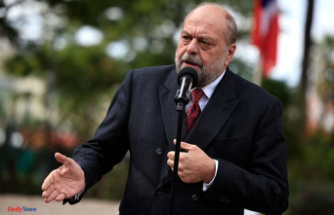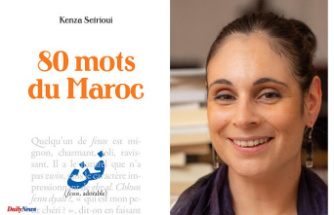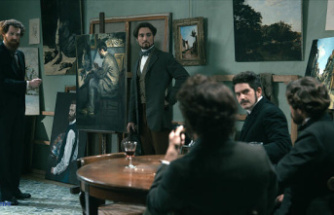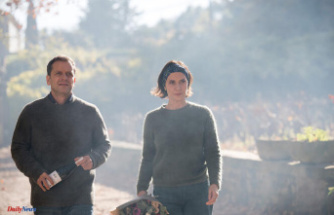Other countries have their royal families - we have the Wagners. For more than 100 years, the family clan has stood for great triumphs, bitter defeats, political entanglements, intrigues - and again and again for great art. In other words, everything that the hearts of a people who have to do without royal weddings and coronation ceremonies. And so the opening of the Bayreuth Festival is a first-rate media event year after year. What exactly is special about the Richard Wagner Festival? We reveal everything you need to know about the most important German music festival.
With the construction of the Festspielhaus, Richard Wagner erected his own monument during his lifetime: He built a place where he could uncompromisingly concentrate on the performance of his own works, away from the big cities. In particular, the focus should be on the performance of his opera cycle "Der Ring des Nibelungen". In order to implement his bold plans, however, the notoriously cash-strapped composer was dependent on generous sponsors: in addition to King Ludwig II of Bavaria, this was above all his patron Marie von Schleinitz: she was involved in the Bayreuth patronage association, which pursued the goal of organizing the Bayreuth Festival enable fundraising. The first considerations for a separate festival hall go back to the year 1850. At that time Wagner wrote to his friend Theodor Uhlig: "Here, where I am right now and where some things are not so bad, I would create a crude theater according to my plan on a beautiful meadow near the city of board and beams and only with the Have the decorations and machinery provided that are necessary for the performance of Siegfried." In 1871 Wagner visited Bayreuth for the first time. Although the Margravial Opera House proved unsuitable for Wagner's intentions, he took a liking to the city. So he decided to set up his theater there.
In 1871, the municipal council of Bayreuth gave Wagner a site on a green hill outside of the city - hence the name, which is often used synonymously for the festival hall.
When Richard Wagner and his wife Cosima were alive, it was already clear that nothing else but his music dramas would be played. Wagner's son continued this tradition. In his will from 1929, Siegfried stipulated that only his father's works could be performed in Bayreuth. And so to this day, apart from very few exceptions - Beethoven's 9th symphony is allowed - only Wagner is played on the Green Hill. But not the whole Wagner. Wagner himself did not consider his first three operas "Das Liebesverbot", "Die Feen" and "Rienzi" to be Bayreuth-worthy, which is why they have been left out to this day. The program of the Bayreuth Festival essentially consists of the following ten works: "The Flying Dutchman", "Tannhäuser", "Lohengrin", "Tristan and Isolde", "Die Meistersinger von Nürnberg", "Parsifal" and the four from the cycle The operas "Das Rheingold", "Die Walküre", "Siegfried" and "Götterdämmerung" belong to "Der Ring des Nibelungen".
Those who see the Festspielhaus for the first time will be disappointed. Seen from the outside, the building appears comparatively inconspicuous. It manages entirely without decorative elements, which is why the house is disrespectfully called "barn". But that should definitely be in Wagner's sense. He actually wanted to give the impression of "hurriedly timbered festival halls", which should give the whole thing a folksy character. Inside, too, the visitor does not expect plush and pomp. The auditorium, which seats 1,974, is simply furnished and consists of evenly rising rows of seats based on antique models Amphitheater. This ensures an almost ideal view from all seats. Another special feature of Bayreuth is the strong blackout of the theater space. Nothing should distract the audience from what is happening on the stage.
What distinguishes the Festspielhaus in Bayreuth from other concert halls is the unique acoustics. There are several reasons for this: On the one hand, the entire interior is made of wood, with a cavity underneath - it offers an ideal sounding board for the music. On the other hand, Wagner had the orchestra pit, which he described as a "mystical abyss", shielded from the audience with a sound cover. The viewer is not distracted by the "trouble of producing the sound". This reinforces the stage illusion. Above all, however, this is the condition for the famous Bayreuth "mixed sound". Because the music does not flow directly from the orchestra into the audience, but is projected onto the stage, where it mixes with the voices of the singers and from there is thrown into the audience as an overall sound. Individual instruments can no longer be located. This creates an orchestral sound that spreads evenly throughout the room. You can hear equally well everywhere.
Yes and no. As mentioned above, the interior of the Festspielhaus is actually made of wood - including the chairs. Experienced Bayreuth visitors therefore have a seat cushion with them - so that their buttocks don't have to suffer for the ear candy. There are often misconceptions about the length of Wagner operas. Although his main work "Der Ring des Nibelungen" actually lasts around 16 hours, the cycle is divided into four evenings, so that the viewer has to sit for a maximum of five hours - interrupted by two breaks.
The Richard Wagner Festival was a family business for almost 100 years, dominated by the composer and his descendants. And even today the festivals are directed - at least artistically - by the Wagners. After Richard's death in 1883, his widow Cosima took over the management of the festival, which was still very irregular at the time. In 1908, for health reasons, Cosima handed over the baton to her son Siegfried Wagner, who mastered this task admirably and carefully modernized the festival. After his death in 1930, Siegfried's widow Winifred took over the reins - an ardent admirer of Hitler who ruined the Bayreuth Festival's reputation in the art world for good. So after the Second World War there was an artistic restart. In 1951 the Richard Wagner Festival took place again for the first time, under the artistic and organizational direction of Wagner's grandsons Wieland and Wolfgang Wagner. The two mucked up ideologically and dared to make a new aesthetic start. In particular, Wieland Wagner, who died in 1966, played a major role in Bayreuth's rise to the premier league of music festivals with his bold productions.
The festival lost a good part of its reputation under the long sole rule of patriarch Wolfgang Wagner, who remained artistic director of the festival until 2008. Critics complain about the often conservative staging and the lack of an innovative overall concept. In Bayreuth, "Wagner is sung today, as one might have done in Stuttgart or Dresden in the past," criticized Die Zeit a few years ago. The Richard Wagner Foundation Bayreuth has been the sponsor of the Bayreuth Festspielhaus since 1973. Foundation members are the Federal Republic of Germany, the Free State of Bavaria, the City of Bayreuth, the Society of Friends of Bayreuth, the Bavarian State Foundation, the Upper Franconia Foundation, the District of Upper Franconia and members of the Wagner family. The statutes of the foundation also regulate the management of the festival and state that members of the Wagner family are to be given preference. The Foundation therefore chose his daughters Katharina Wagner and Eva Wagner-Pasquier as Wolfgang Wagner's successors, who were responsible for the Bayreuth Festival for the first time in 2009. Katharina Wagner is now the sole manager.
Since 1986 the festival has been organized by Bayreuther Festspiele GmbH. This is made up of representatives of the Federal Republic of Germany, the Free State of Bavaria, the City of Bayreuth and the Society of Friends of Bayreuth, each with 25 percent of the votes.
The federal government and the Free State of Bavaria each contribute a third to the uncovered costs. The last third is shared by the city of Bayreuth, the district of Upper Franconia and the "Society of Friends of Bayreuth". In absolute figures, this means that the federal government is currently adding 2.3 million euros in tax money for the spectacle, and the Free State of Bavaria is also contributing the same amount. On the one hand, that sounds like a lot of money. However, 60 percent of the expenses for the Richard Wagner Festival are covered from own funds - the subsidies from the public sector are less than 40 percent. For comparison: municipal theaters in Germany are subsidized with an average of more than 80 percent.
Certainly not for representative reasons. The long-time Chancellor Angela Merkel was regularly in Bayreuth as a self-confessed Wagner lover. Your predecessors Gerhard Schröder and Helmut Kohl, on the other hand, could afford to avoid the festival. The incumbent chancellor, Olaf Scholz, has not yet attracted attention as a Wagner enthusiast.
In addition to Angela Merkel, many high-ranking personalities from politics and business regularly come to Bayreuth. Even the Green Party politician Claudia Roth raves about Richard Wagner's music. The celebrity density is also high outside of politics: Thomas Gottschalk is a regular guest, Uschi Glas, Roberto Blanco, Princess Gloria von Thurn und Taxis are also happy to be present. Even if it seems difficult for some to voluntarily sit on uncomfortable wooden benches for five hours: Many accept this sacrifice because they are addicted to music and forget all earthly plagues with the sounds of Wagner. Of course, the Bayreuth opening is also a social must-attend event. For one or the other it is always about seeing and being seen.
no The fact that chancellor, minister and show stars travel to Bayreuth is not a fad of the third millennium. Emperors, kings and numerous great minds were present at the opening of the first Richard Wagner Festival in 1876. With Franz Liszt, Anton Bruckner, Camille Saint-Saëns, Peter Tchaikovsky and Edvard Grieg, outstanding composers of their time were present. In addition, the Russian writer Lew Tolstoy, the philosopher and Wagner friend Friedrich Nietzsche and the architect Gottfried Semper. And of course King Ludwig II of Bavaria was there. After all, he had financed all the fun.
There are 30 performances a year, all of which are sold out. Since the Festspielhaus holds almost 2000 spectators, there is the possibility for around 58,000 spectators to get hold of a ticket. However, this is an art in itself, because there are requests for more than half a million tickets every year. For a long time you could only order tickets for the Bayreuth Festival in writing via the ticket office - and then be patient, the waiting time lasts several years. You can now buy tickets online.
There is another way to get tickets: Every year, the Richard Wagner Association awards grants, primarily to enable students to attend the performances.
For a festival of this category, the prices are surprisingly moderate. The most expensive seats recently cost 332 euros for many performances, such as “Lohengrin”, while the cheapest ticket was available for 43 euros. In addition, a small number of seats with limited (21 euros) or no view are available for 10 euros.












